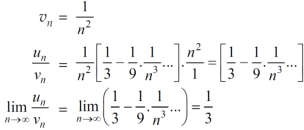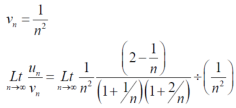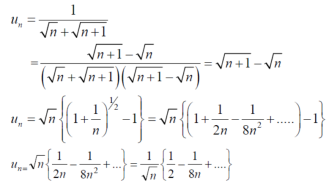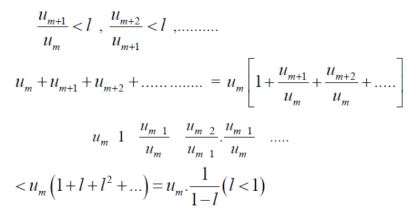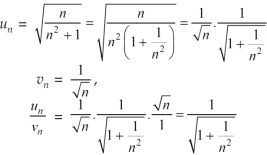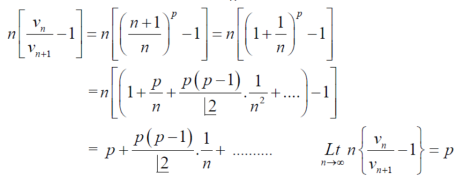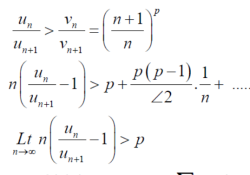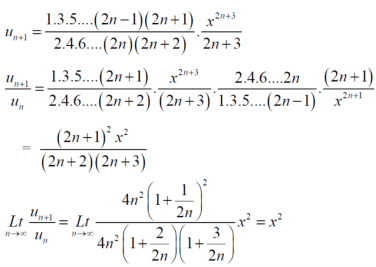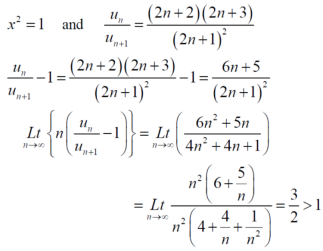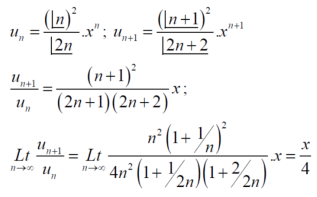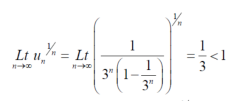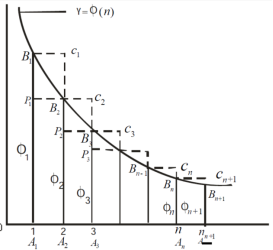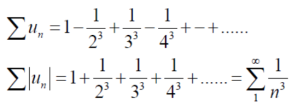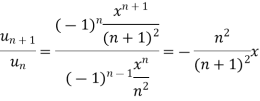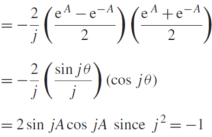UNIT-2
Sequence and series
Sequence– A function f : N The sequence is written as f(1) , f(2) , f(3) , f(4)……….f(n). Any sequence f(n) can be denoted as <f(n)> or {f(n)} or (f(n)). Suppose f(n) = Then it can be written as -
Example: suppose we have a sequence – 1 , 4 , 9 , 16 ,……….. and its n’th term is This sequence can be written as -<
Example:
Types of sequences – 1. Finite sequence- A sequence which has finite number of terms is called finite sequence. 2. Infinite sequence- A sequence which is not finite , called infinite sequence.
Limit of a Sequence- A sequence <
Example: If
Hence the limit of the sequence is 1/2 .
Some important limits to remember-
Convergent sequence- A sequence Sn is said to be convergent when it tends to a finite limit. That means the limit of a sequence Sn will be always finite in case of convergent sequence. Divergent sequence- when a sequence tends to ±∞ then it is called divergent sequence. Oscillatory sequence- when a sequence neither converges nor diverges then it is called oscillatory sequence.
Note- a sequence which neither converges nor diverges , is called oscillatory sequence. A sequence converges to zero Is called null.
Example-1: consider a sequence 2, 3/2 , 4/3 , 5/4, …….. hereSn = 1 + 1/n Sol. As we can see that the sequence Sn is convergent and has limit 1. According to def.
Example-2: consider a sequence Sn= n² + (-1)ⁿ. Sol. Here we can see that, the sequence Sn is divergent as it has infinite limit.
Example: suppose
Series Infinite series- If It is denoted by Examples of infinite series-
Covergent series - suppose n→∞ , Sn→ a finite limit ‘s’ , then the seiresSn is said to be convergent . We can denote it as,
Divergent series- when Sn tends to infinity then the series is said to be divergent.
Oscillatory series- whenSn does not tends to a unique limit (finite or infinite) , then it is called Oscillatory series. Properties of infinite series – 1. the convergence and divergence of an infinite series is unchanged addition od deletion of a finite number of term from it. 2. if positive terms of convergent series change their sign , then the series will be convergent. 3. Let 4. Let
Example-1: check whether the series Sol. As we know that, Sn = Therefore, Sn = Now find out the limit of the sequence,
Here the value of the limit is infinity, so that the series is divergent as sequence diverges.
Example-2: check whether the series
Sol. The general formula for this series is given by, Sn = We get,
Hence the series is convergent and its values is 3/2.
Example-3: check whether the series Sol. The general formula can be written as,
We get on applying limits,
This is the convergent series and its value is 3 / 4
Example-4: check whether the following series is convergent or divergent. If convergent, find its value.
Sol. n’th term of the series will be,
General properties of series The general properties of series are- 1. The nature of a series does not change by multiplication of all terms by a constant k. 2. The nature of a series does not change by adding or deleting of a finite number of terms. 3. If two series
Exampple-1: prove that the following series is convergent and find its sum.
Sol. Here,
And
Hence the series is convergent and the limit is 1/2 .
Example-2: Test the convergence of the series- Sol. Here we can see that the given series is in geometric progression As its first term is 1 and common ratio is ½. Then we know that the sum of n terms of a geometric progression is-
Hence the limit will be-
So that the series is convergent. |
Key takeaways
- A function f : N
 , where S is a non-empty set , is called sequence , for each nϵN.
, where S is a non-empty set , is called sequence , for each nϵN. - A sequence Sn is said to be convergent when it tends to a finite limit.
- When a sequence tends to ±∞ then it is called divergent sequence.
- If two series
 and
and  are convergent, then
are convergent, then  is also convergent.
is also convergent.
Positive term series- If all the terms in an infinite series are positive after few negative terms , then the series said to be a positive term series. Suppose , -22-65+ 55 +69 99+125+………….is a positive term series. If we remove these negative terms, then the nature of the series does not change. Comparison test- Statement- Suppose we have two series of positive terms
Proof- we know that by the definition of limits, there exist a positive number epsilon(ε) Which is very small. Such that According to definition (comparison test) | k-ε< ignoring the first m terms of the series, we get k-ε< there will be two cases- case-1:
From (1),
Therefore Case-2: :
From eq. (1)
Then
From(2)
Hence,
Example: Test the convergence of the following series.
Sol. We have First we will find
And
Here, we can see that, the limit is finite and not zero, Therefore, Since So that , we can say that,
Example: Test the convergence of the following series-
Sol. Here we have the series,
Now,
Now comapare
We can see that the limit is finite and not zero. Here
So that,
Example: Show that the following series is convergent.
Sol.
Suppose,
Which is finite and not zero. By comparison test But,
Is convergent. So that
Example: Test the series:
Sol. The series is,
Now,
Take,
Which is finite and not zero. Which is finite and not zero. By comparison test But,
Is divergent. ( p = ½) So that |
Key takeaways
- Suppose we have two series of positive terms
 and
and  then,
then,  , where k is a finite number, then both series converges or diverges together.
, where k is a finite number, then both series converges or diverges together.
Statement- suppose 1. if k<1 , the series will be convergent. 2. if k>1 , then the series will be divergent. Proof: Case-1:
We know that from the definition of limits ,it follows,
But,
Is the finite quantity. So Case-2:
There could be some finite terms in starting which will never satisfy the condition,
In this case we can find a number ‘m’,
Ignoring the first ‘m’ terms, if we write the series as
We have , in this case
So that
Example: Test the convergence of the series whose n’th term is given below- n’th term = Sol. We have
By D’Alembert ratio test,
So that by D’Alembert ratio test , the series will be convergent.
Example: Test for the convergence of the n’th term of the series given below-
Sol. We have ,
Now , by D’Almbert ratio test At x = 1 , this test fails. Now , when x = 1
The limit is finite and not zero. Then by comparison test, Since Hence Therefore in the given series |
Key takeaways
|
Statement- suppose
1. the series is convergent if k>1 2.the series is divergent if k<1. 3. test fails at k = 1 Proof: let us consider the series,
Case-1: in this case,
We choose a number ‘p’ for all k > p >1 , comparing thr series We get
That means,
If k >p , which Is true . hence We can prove the second case similarly.
Example-1: Test the convergence of the following series.
Sol. Neglecting the first term the series can be written as,
So that,
By ratio test
By Raabes’s test
Example-2: Test the convergence of the series,
Sol. As we will neglect the first term, we get
By ration test The rario test fails, then
By Rabee’s test
Example-3: Test the nature of the following series:
Sol.
By ration test The rario test fails, then
By Rabee’s test
Example: Check for the convergence of the following series:
Where x>0. Sol. Here , we have the series,
Neglecting the first term , we get
we get the limit,
By ratio test, But at Now we will apply Raabe’s test
So that by Raabe’stest , the series converges. Therefore |
Statement- Suppose
Then, 1. if k>1 , then the series is convergent. 2. if k<1 , then the series is divergent.
Proof: if k>1 Compare
Taking log on both sides, we get
k>p which is true as k>p>1 hence When p<1, Similarly when p<1, then At p = 1 , then this test fails.
Example: Test the convergence of the following series:
Sol. We have the series,
Here ,
Which gives,
If
Thus the series is divergent. |
Let
Then Proof: case-1:
Or
Since,
Is a geometric series with common ratio <1 so that the series will be convergent. Case- 2:
By the limit concept, we can find a number,
That means
After 1st ‘r’ terms , each term is > 1
So that the series is divergent.
Example: Test the convergence of the series whose nth term is given below-
Sol.
By root test
Example: Test the convergence of the series whose nth term is given below-
Sol.
By root test
Example: show that the following series is convergent.
Sol.
By root test
Example: Test the convergence of the following series:
Sol. Here, we have,
Therefore, the given series is convergent. |
A positive term series ∅(1) + ∅(2) +∅(3) + ∅(4)+ …………..∅(n) + ……… Where ∅(n) decreases as n increases , is convergent or divergent according as the integral
Proof: suppose, Sn = ∅(1) + ∅(2) +∅(3) + ∅(4)+ …………..∅(n) Here n = 1,2,3,4,………n , n+1, …….. Hence the total area under the curve ( see fig) lies between the sum of areas of all interior rectangles and sum of the area of all exterior rectangles So that,
As n tends to infinity , then limit of Sn will be finite or infinite according as
Example-1: determine the following series is convergent or divergent.
Sol. By using integral test
By the integral test, given series is divergent as
Example-2: Test the series by integral test-
Sol. Here Now apply integral test,
Let,
X = 1 , t = 5 and x = ∞ , t = ∞, Now,
So by integral test, The series is divergent.
Example-3: Test the series by integral test- Sol. Here By using integral test,
= We get infinity, So that the series is divergent. |
1. If the series of terms Be such that the series | Is convergent, then the series 2. If
Absolute convergent- A series
For example- suppose the following series,
By p- series test, we can say that Hence Note- if the series has positive terms and it is convergent then this series will be absolutely convergent too. An absolute convergent series will be convergent but the converse may not be true.
Conditional convergence-: If the series
Example: Show that the series Sol. We have,
| The first condition and second conditions are- 1. | 2. Both the conditions are satisfied. So that we can say that by Leibnitz’s rule, the series is convergent. The series is also convergent by p-test as p = 2 > 1. Hence the given series is absolutely convergent.
Example: Test the convergence/Divergence of the series:
Sol. Here the given series is alternately negative and positive , which is also a geometric infinite series. 1. suppose, S = According to the conditions of geometric series, Here , a = 5 , and common ratio (r) = -2/3 Thus, we know that,
So , Sum of the series is finite , which is 3. So we can say that the given series is convergent. Now. Again sum of the positive terms,
The series is geometric, then A = 5 and r = 2/3 , then Sum of the series,
Sum of the series is finite then the series is convergent. Both conditions are satisfied , then the given series is absolutely convergent.
Example: Test the series for absolute/conditional convergence.
Sol. The given series is an alternating series of the form,
Here, 1.
2.
And,
Hence bt Leibnitz’s test , the given series is convergent , But,
Is divergent by p-series test. So that, the given series is conditionally convergent.
Example: Test for the convergence of the series:
Sol. The given series is,
By ratio test series
Example: Test for absolute convergence:
Sol. Let the series is
By ratio test,
Power series A series of the form Where all the ‘a’ are independent of x, is known as power series in x Interval for convergence- In this power series-
D’Almbert’s ratio test-
If Or in other way if |x|<1/ Thus the interval of convergence of power series is-
Example-1: If the series Sol. Here Then,
By D’Almbert’s ratio test the series is convergent for |x|<1 and divergent if |x|>1. So at x = 1 The series becomes- At x = -1
This is an alternately convergent series. This is also convergent series, p = 2 Here, the interval of convergence is
Example-2: If the series Sol. Here
Then,
By D’Almbert’s ratio test the series is convergent for | Or At x = 0, the series becomes- At x = 2, the series becomes- It is an alternate series which is convergent by Leibnitz rule. So that the series |
Let’s first define the exponential functions- A function which contains Here ‘e’ is the exponent which has an approximate value 2.7183
The power series for The value of
If we obtain an actual value of The more terms we take in the series, the closer will be the value of
Example: Find the value of 5 Sol. As we know that the exponential series is-
Here we get-
Now
Example: Expand Sol. We know that the power series for
Here we have to find- So that-
On solving, we get-
Trigonometric and log function- As we know that,
And By adding these equations-
And subtracting (2) from (1), we get-
Note-
Example-1: Verify Sol. As we know that And Hence,
That means
The following function is a logarithmic function-
‘a’ is any value which is greater than 0, except 1 The natural logarithmic function is-
The value of e = 2.71828182….
Properties of logarithms- 1. 2. 3. 4.
Example: Simply the logarithm Sol. We can write this as-
= 3
Example: Simplify Sol. We know that-
So that
|
References
- E. Kreyszig, “Advanced Engineering Mathematics”, John Wiley & Sons, 2006.
- P. G. Hoel, S. C. Port And C. J. Stone, “Introduction To Probability Theory”, Universal Book Stall, 2003.
- S. Ross, “A First Course in Probability”, Pearson Education India, 2002.
- W. Feller, “An Introduction To Probability Theory and Its Applications”, Vol. 1, Wiley, 1968.
- N.P. Bali and M. Goyal, “A Text Book of Engineering Mathematics”, Laxmi Publications, 2010.
- B.S. Grewal, “Higher Engineering Mathematics”, Khanna Publishers, 2000.
- T. Veerarajan, “Engineering Mathematics”, Tata Mcgraw-Hill, New Delhi, 2010
- Higher engineering mathematics, HK Dass


































































































